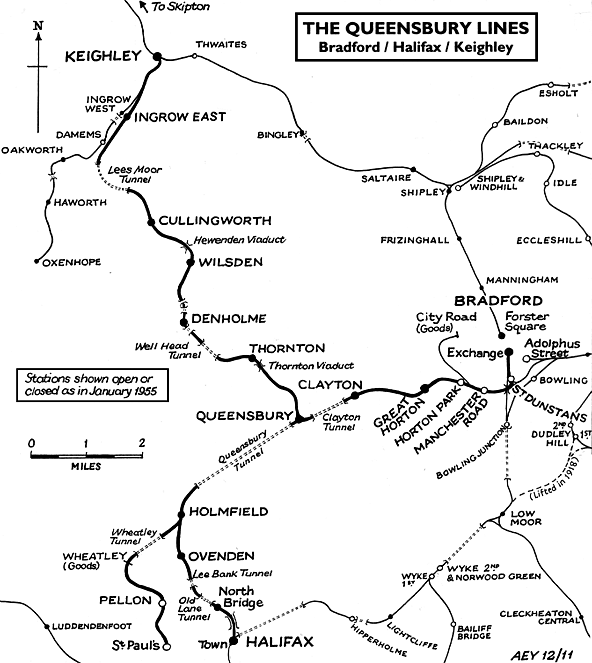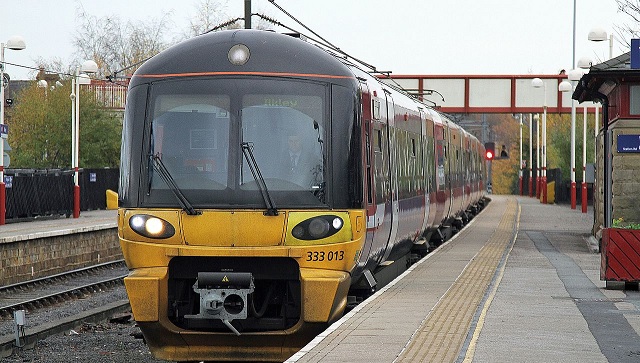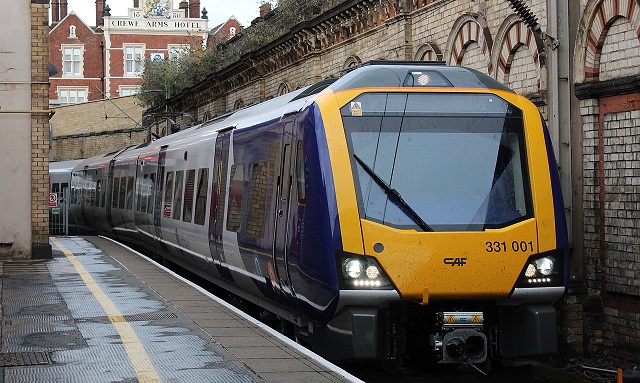Railopedia Article: Northern Spirit
History
After Government efforts to seek the privatisation of British Rail itself were defeated in Parliament, attention diverted to the privatisation of several smaller isolated networks. These routes would be separated from British Rail, and allowed to operate fully privately, under a de facto 20 year lease, with "public safeguards" built in to the lease. One network so designated was the "Leeds North West" network, and this was privatised via a management buyout by former British Rail managers via a competitive auction.
The network stretched from Leeds in the east, where they used the former Leeds Central station, which was renamed to "Leeds Piccadilly" to more easily separate it from the adjacent "Leeds Central" station which would continue to be used by British Rail (*1). In preparation for the separation (and by co-incidence), British Rail had been working on diverting all services along the Airedale Line via Bradford and in to Leeds via Pudsey (*2) (or towards Wakefield via Cleckheaton), with all services from Caldervale Line (from Halifax) no longer running through Bradford, but using a southern station reopened at Bradford Bowling. All this left the route between Leeds, Bradford and Ilkley/Skipton separated after a new bridge was built in Leeds to access the new Piccadilly station (passing over the BR tracks from Harrogate). Along with this triangular network, running as far north as Skipton, the tracks continuing west of Skipton were granted to the company reaching Burnley, Blackburn and eventually Preston. Despite interest in reviving the former Harwood Loop Line, the trackbed remained derelict, eventually being turned in to a public pathway popular with dog walkers, especially over the Martholme Viaduct.
By 1996, a rebanding effort as "Northern Spirit" had taken place (later shortened to just "Northern" by 2005), with a new livery of green on purple and stylised "N" on. Later sub-branding divided services in to "Northern Connect" for the local stopping services, and the "Northern Express" for the express Leeds-Preston services.
In 2014, Northern became one of the elite few private rail operators to have their lease extended for a further 30 years by the coalition Government (*3), after consistently being rated higher then British Rail by local residents and receiving backing from local government. Private rail as a concept remains controversial, but three successful private operators remain across the country. As part of this, Northern agreed to increase certain services, due to overcrowding on some services, in return for a continuing operating subsidy. The process for implementing this is ongoing, as new rolling stock is required.
Services
Northern currently operate a "base 2tph" on most local "Northern Connect" services in West Yorkshire and Lancashire, with the service to be increased on certain routes:
- Bradford to Ilkley (1tph, to be 2tph by 2020)
- Preston to Burnley (2pth)
- Bradford to Leeds (2tph, to be 4tph by 2023)
- Leeds to Ilkley (2tph, due to start in 2023)
The Northern Express service, operating from Leeds to Preston, and calling only at limited stops in between will also be made faster by omitting smaller stops once the new local service between Leeds and Ilkley begins operation. Such works has required an upgrade in road/rail crossings, particularly in Lancashire. Bamber Bridge in particularly received a new bridge to avoid trains halting cross-town traffic on the road each time a service passed through.
Business Success
Part of the reason for Northern's success has been it's small and closely targeted operations across two urban areas, and subsequent close relationship with local government who subsidised the local services (*4). Private business techniques were adopted; a smaller management layer then British Rail reduced costs, whilst locally empowered station managers (within a defined scope) allowed quicker action on faults and issues and a relentless drive to reduce operational costs even if it required investment. The local station managers were responsible for the station by station rapid deployment of wifi in almost all Northern stations as a locally driven programme, rather then a top-down order. These actions also helped mitigate against service issues in 2000 (*5) when Northern imposed driver only operation and reduced the guard role to optional onboard, resulting in driver strikes for several periods in 2000 before an agreement to retain the full guard role on what would become the Northern Express service and a pay rise for drivers brought the dispute to an end.
Another significant reason for Northern's success has been their backing (at times financial as well as political) for line side projects. New housing projects along with new stations at Rodley and Apperley brought new passengers to the line accessing Leeds (and to a lesser extent Bradford). New stations in city suburbs (often financial supported particularly by West Yorkshire) widened the scope of potential passengers as road congestion increased. A large out-of-town shopping village opened at Kirkstall Forge opened in 2015 with a new train station integrated in to, and at the heart of, the design with many new apartment homes also on the site, and a similar smaller project in eastern Blackburn also now under construction. All these side investments have increased the number of potential passengers living within easy access to a Northern station, whilst also providing more destinations easily served by Northern trains for passengers. (*6)
Finally, Northern's forward looking management came to agreement with Transport for London in 2007, allowing them to adopt Oyster cards for ticketing, and began issuing their own version in 2008, marketed as the "M Card" (for Metro Card). Whilst the early days of Northern featured higher then normal ticket costs as they attempted to update the railway, attracting opposition, business transformation and reduce operational costs, post 2006 days brought static ticket costs static despite inflation, drawing significant praise locally and allowing passenger numbers to continue to rise rapidly in the late 2000s despite the economic woes nationally.
Trains
Following privatisation, the network operated with a rag tag assortment of services, with many operated using older diesel locomotives from British Rail and old coaches stock. The later 1990s saw a large upswing in rail passenger numbers however, and subsequently a new order for a standardised "Northern Train" was placed in 1999 with train manufacturers for a new 4 coach train ("Northern A Stock"). Moving away from British procurement, with the main UK builders not being particularly innovative with their designs, the order eventually was placed with the Spanish train builder CAF. The train would feature 2-abreast standard seating only, and would also be capable of diesel or electric traction, with Northern expressing interest in electrifying the route to further decrease operating and maintenance costs. The train was fast accelerating (especially under electric power), and featured regenerative braking, whilst much of the train equipment was placed in modular units under the carriages, allowing quick swap of faulty kit to allow the train itself to keep operating. Electrification began in 1999, using much of British Rail's initial preparation for the Leeds/Bradford area electrification scheme (which did not see execution under British Rail), before later being extended in 2009 when cheap loans and a subsidy from Government were available in order to keep the economy going during the recession. Existing trains were able to use the provided electricity straight away, providing more and more savings as electrification spread out and was switched on.
A subsequent order was placed in 2017 for "Northern B Stock", which would see Northern Express services get new trains, with the existing A stock cascading over to Northern Connect services to provide the improved service levels. The B stock will see a 4 coach multiple unit again, but again controversially (given the longer distance journeys) with no first class area. More comfortable 2-abreast seating would be provided however, with all seating centred around tables with Firewire connections (*7) for charging phones/tablets/computers and providing internet access, whilst the trains will be fully electric and faster to accelerate, resulting in time savings on the route.
A Stock terminating at Ilkley from Bradford
B Stock pulling in to Preston from Leeds
On Sundays only, a reserved-seat only, non-stop special service operates from Leeds to Preston and return again. This is operated by one of two preserved steam locomotives, and refurbished old coaching stock (inherited from British Rail upon taking over the route):
- Former British Rail Class 9F, named Red Rose
- Former LNER Class A4, named White Rose
Other locomotives on tour from heritage lines or private collectors have also occasionally operated the Sunday service, with an LMS Class 5MT from the North Yorkshire Railway being a more regular sight.
Ocassional freight trains, operated by private freight operator EWS can also be seen, hauling aggregates from quarries near Grassington.
Ticketing
When the route was taken over by Northern, much of the ticketing systems used legacy British Rail processes, with small paper tickets and manual on-train checks. New computerised ticket machines were installed at most major stations within a few years, allowing passengers to purchase tickets without needing to use the ticket office, and utilised magnetic stripes on the back which encoded the ticket information. This allowed ticket barriers to be installed at several key stations to cut down on fare evasion, despite such a move being unpopular with the public at large. Growing passenger numbers through the early 2000s led to further difficulties with ticket sales (especially at ticket gated stations), and led to agreement with Transport for London in 2007 to use the Oyster card system (8), following in the footsteps of the C2C operator a few months prior. This led to the entire network being separated in to zones, with the fare calculated using the Northern ticketing system computers, before the fare then being processed and paid for using the existing Oyster system. Rather then using the concentric zones system of London however, simplification of the ticketing system for Northern took the place of five adjacent zones (or grouped stations), with the fare calculated upon how many zones you passed through. More urban zones cost more than the rural ones, whilst the fare is also time dependant on when you travel. In 2008, Northern began issuing their own "Oyster Card", branded as a "SpiriCard" in homage to the company's original name, although they remain mutually interchangeable.
Similarly to London, season tickets are issued on a photocard version of the SpiriCard, with under 18s also able to get a photocard version for 1/3 discount on all travel (including peak time). The cards also feature a topup money wallet for pay as you go travel, which in a move which predates London by several years, Northern began to use for payment at "platform side" concessions; tea/coffee/snack stands, and other small fee shops in the stations (*9). By 2012, the SpiriCard could be used at parking machines in station car parks as well, with other shops close to a station also beginning to experiment in accepting payment by SpiriCard; a McDonalds in Accrington became the first fast food outlet to accept it.
Project Evergreen
Project Evergreen is the Northern strategy for the next 20 years of operation in the North. Potential aims include (*10):
- Continuing to invest in line-side sources of traffic for the route; either housing estates built around a Northern station, or shopping outlets near to a station.
- Working with local authorities to push more passengers towards public transport.
- Negotiating with Merseyside local authorities over access to Liverpool via the Preston-Liverpool Line.
- Continuing work to reopen the Preston Urban Line, extending the existing route through Preston station and out to the north-east towards Longbridge.
- Taking over the Leeds-Harrogate-York & Northallerton Line.
- Resignalling the entire line using a new version of the common Balise Based Signalling system to further reduce maintenance requirements and reliability. An exception, which would have allowed Northern to deviate from the common standard, was turned down by the Department of Transport in order to allow cross-network trains where required (predominately for freight).
Many of these are future aspirations, and time will tell which are carried through.

------------------------------
Notes:
(*1) As mentioned previously when discussing Leeds station in the West Yorkshire Pullman article.
(*2) As discussed a long time ago; Bradford had it's stations connected, so Airedale Line services from Skipton run via Bradford on their way to Leeds.
(*3) So in this TL, there are a few private rail operators, as a legacy of the 1990s movement, but it's not widespread. In part, the fact that the few successful operators (I'm thinking there are three in this TL) have full control of train and track, and separate ticketing, means there isn't a public appetite for doing any more as it'll segregate the network and eliminate cross-border trains (whether passenger or freight).
(*4) Never bite the hand which feeds you; Northern has forged a close relationship especially with West Yorkshire authorities.
(*5) In terms that better passenger information and people able to respond to questions are available unlike OTL; the train service itself will still be affected.
(*6) Kind of similar to OTL in West Yorkshire, who have reopened several stations. Here the focus is on making sure either housing or attractions are trackside, to enable the train to be used; in a slightly similar approach to the Japanese private rail operators..
(*7) As mentioned previously, I've already established Firewire for charging phones/network, so it carries here.
(*8) Well established smart card ticket mechanism, private rail operator with more freedom to innovate then OTL; seems like a quick and easy win.
(*9) This bit is directly comparable to Japan; why TfL don't allow in station tea/coffee/snack points to allow payment by Oyster I don't know - the payments are only going to be a couple of quid each time. Maybe financial rules about being a payment provider? Not sure.
(*10) The name is from Chiltern Railways long term objectives, but the rest of this is just possible future stuff for Northern. The only really realistic major options are the takeover of the Harrogate Lines from Leeds to Northallerton & York, and the route resignalling. Otherwise it's just gradual improvements along the line to keep building passengers numbers; once numbers get high enough to introduce a 3tph service on some routes, a service every 20 mins is almost enough for passengers to ignore timetables and turn up and go (usually considered 1 train every 15 mins, but 20 mins isn't exactly a long way off).
------------------------------
It was built badly, on the cheap, too close to some major coal workings. First remedial works were needed before they had even finished building it, repairs were a regular requirements and it leaked it's entire life.
It was shut to passengers before WW2 so it can't have been that much of an important link, though I admit I don't know the rail network up there that well.
Remember as well, here the Bradford "Crossrail" project came through, so that link is going to be pointless; traffic can cross at Bradford rather then clog up Leeds West junctions.
I think those routes are gone as per OTL; Keighley-Oxenhope is a heritage line as per OTL.




